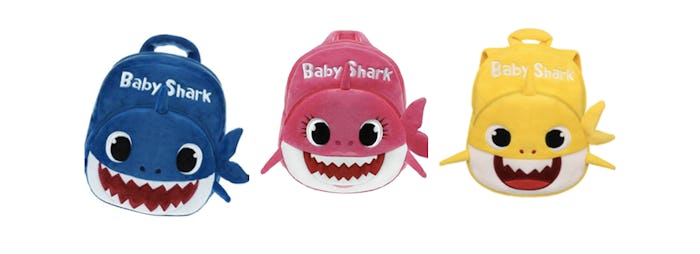Life

These Plush Baby Shark Backpacks From Amazon Are Less Than $9
Ah, Baby Shark. Two words that spark joy in the hearts of the toddler set and pained expressions in the eyes of their parents. One of YouTube's biggest sensations was originally created by Pinkfong in 2017 and has been watched over 3 billion times to date. Whew. The video's popularity is due in part to its catchy "earworm" melody, easy-to-sing lyrics, and vivid animation. And for kids that love to sing along to "Baby Shark," now they can wear him when they head off to preschool, too. That's right, I recently discovered a Baby Shark backpack on Amazon.
This new on-the-go product for kids is the perfect size for a preschooler's backpack or a trip to Grandma's house. Straps are adjustable for optimal comfort, and the backpack's plush material is soothing to little ones. Your little shark can even pick out the color they like best (blue, pink, or yellow), and each one is less than $9. I have to admit, this backpack is pretty adorable, even though I can't say the song, which amazingly hit the Billboard Top 100 list in January, doesn't grate on my nerves every time I hear it. But will I be singing "Mommy Shark" to myself an hour after finishing this post? Most likely.
So, exactly how does a song that's main lyrics are "doo doo doo doo" become a viral sensation, topping music charts and jump starting family dance parties whenever it is turned on? As it turns out, the answer to Baby Shark's popularity is science. In an interview with the Daily Beast, Beatriz Ilari, an associate professor at the University of Southern California’s Thornton School of Music, said, "The song has a simple melody that is not only ‘catchy,’ but is also easy to sing and memorize." Toddlers have a limited vocabulary, so simple is best and why repetition is a key element in children's songs and books. Apparently this works on adults, too, as that repetition is why we'll find ourselves mindlessly humming the song. I can attest to this.
The second element that makes the song catchy is the subject: family and animals. Ilari called this “compositional devices," and because the subjects are family, and every family member is repeated four times, it further embeds the song in kids’ minds. Valorie Salimpoor, a neuroscientific consultant who has conducted studies on how music affects the brain, told the Daily Beast, “Children can affiliate with the words baby, daddy, mommy, grandpa, grandma. This helps create a connection or a bond with the music. These are people that children are likely to have a very positive connection with, again providing a pathway to target the emotion and reward systems in the brain.”
Ilari and Salimpoor also credited the song's popularity to its upbeat tempo. Salimpoor said, “[Faster music] targets the brainstem and other ancient brain systems in our brain and has the potential to stimulate dopamine systems involved in movement as well."
Lastly, Baby Shark is not just a song. The video component has a high production value, bright, vivid colors and toddler-friendly dance moves that make children want to watch the video again and again. I would venture it's all making a bit more sense now, am I right? I must say I feel sort of relieved that I can blame my Baby Shark humming on scientific reasoning.
If Baby Shark mania has taken over your home, and you realize a backpack will be the first of many Baby Shark-themed products in your future, here's a list of additional Baby Shark items that are making the rounds among preschoolers these days.
This article was originally published on